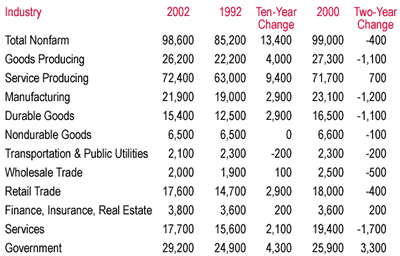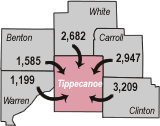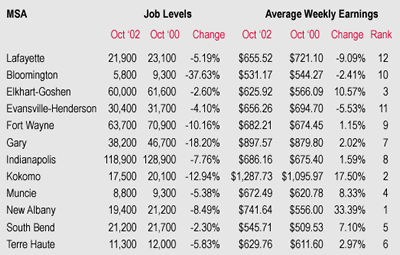Lafayette
Indiana Business Research Center, Kelley School of Business, Indiana University, Indianapolis
The Lafayette metropolitan area (Tippecanoe and Clinton counties) was the
third fastest growing metro area in Indiana, based on the change in population
between the censuses of 1990 and 2000. At a rate of population growth of 13.2
percent, it was nearly identical to the nation's growth of 13.1 percent and
considerably exceeded Indiana's 9.7 percent growth rate.
Like most of Indiana, the majority of jobs in the Lafayette metro area are
now in the services sector (24.3 percent). Over the ten-year period from October
1992 to October 2002, Lafayette gained 13,400 new jobs, with 9,400 in the service
producing sectors. During the more recent past, between October 2000 and October
2002, the service producing sectors managed to post a small gain of 700 jobs
while other sectors of the area's economy lost jobs (see Table 1).
Table 1
Jobs in the Lafayette MSA: Ten-Year Comparison of October

A still considerable 20 percent of jobs are in manufacturing, with average earnings per job of $48,490 (based on Bureau of Economic Analysis data from 2000). This despite Isuzu pulling out of Suburu-Isuzu Automotive, which just a few years ago had considered building a second plant in the county. However, news reports indicate that Suburu sales remain strong and that Suburu was responsible for 80 percent of the jobs at the plant anyway. More current monthly data show average weekly earnings in manufacturing at $655 for October 2002 (see Table 2). There was also a 100 job increase in durable goods manufacturing between October 2001 and October 2002, while nondurable goods job levels remained constant. Taking a somewhat longer view and using annual averages, jobs in the primary metals industry increased 22 percent between 1995 and 2000 in Tippecanoe County, ranking it sixty-eighth out of 3,141 counties nationwide in percent increase. Positive percentage increases also occurred during that time (from 1995 to 2000) in the industrial machinery and transportation equipment industries.
Table 2
Comparison of Jobs and Wages in Manufacturing in MSAs
Click for Larger Image
Unemployment in the area remains at low levels, despite the recent recession and slowing economy. The Lafayette metro area unemployment rate in September was 26 percent lower than the state's rate of 4.6. While this might not seem to bode well for business prospects seeking a large labor supply, the commuting patterns for the region show large numbers of workers continue to be drawn to the area from other counties, such as White, Carroll, Benton, Warren, and Clinton. More than 20,000 workers reported living elsewhere but working in Tippecanoe County, based on state income tax returns for the year 2000 (see Figure 1).
Figure 1
Commuting into Tippecanoe, 2000

Will Lafayette experience more of the same in 2003? With the state expected to see an increase of 30,000 jobs in 2003, Lafayette can be expected to gain a small share of those jobs, most likely in services, government, and some key manufacturing areas.
Also in this Issue…
- Outlook for 2003
- The U.S. Economy
- The International Economy
- Financial Forecast
- Housing
- Indiana
- Anderson
- Bloomington
- Columbus
- Evansville
- Fort Wayne
- Gary
- Indianapolis
- Kokomo
- Lafayette
- Muncie
- New Albany
- Richmond
- South Bend/Mishawaka and Elkhart/Goshen
- Outlook Summary for 2003
- Return to Table of Contents




